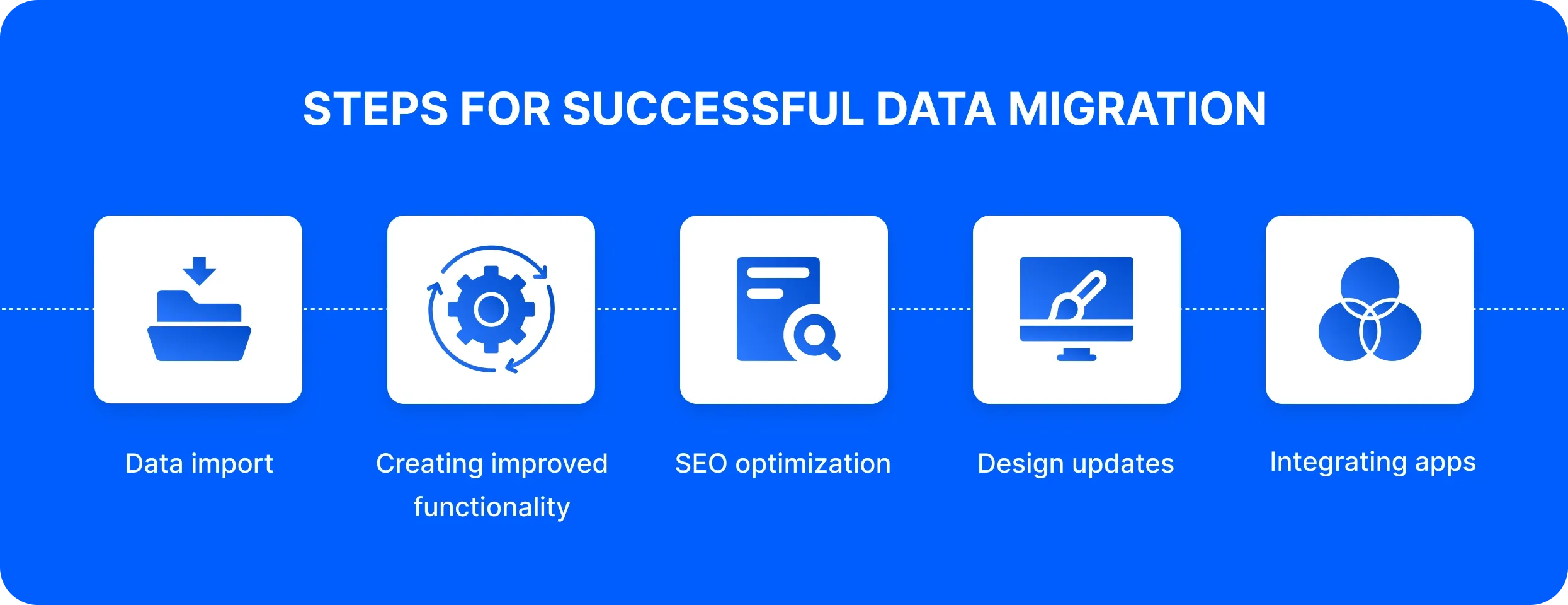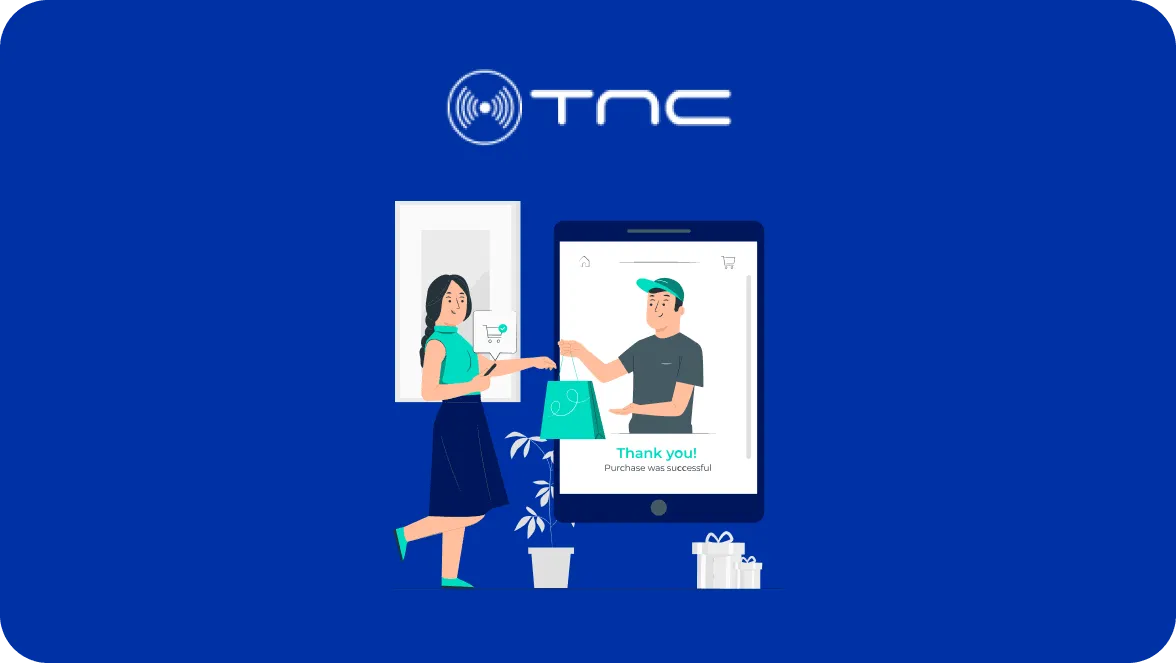
With its first e-commerce site, a business gets basic features and performance. When your company starts growing, you may find that your current platform is too slow, the design is poor, and there are not enough features to scale your business fast. On the other hand, you may face costly upkeep and maintenance, provided by your team or a technical partner. If a company strives to minimize operating costs, replatforming is definitely worth considering.
The need for migration will raise a question of how to do it? How to choose the right platform? How to migrate painlessly and without loss in income? In this guide, you will discover possible risks of replatforming, the way to mitigate them, and how your e-commerce business may benefit from this move.
What is migration and when you may need it
For successful store operation, your website or platform must be suitable and reliable, and meet all operational requirements, as well as customer expectations. If you lack one of these components, it’s better to think about replatforming your e-commerce store!
E-commerce replatforming is a process of migrating from one platform to another, or building an in-house e-commerce solution to improve web performance, change or update specific components, and get advanced functionality.
Even if you assume your system is 'OK' right now, e-commerce retailers should keep abreast, as technology is developing fast! Your platform can become outdated, start to lack necessary tech features, and turn inappropriate for delivering great customer experience. For example, your store is limited or even slows down with trackers, social-media buttons, and other third-party scripts. Your visitors expect an exceptional impression of your online store across channels and touchpoints. If the website’s design and performance are poor and do not satisfy their expectations, it will push them away.
All in all, migration is great because you can upgrade your current website: improve its performance or metrics, add new features or capabilities, and increase usability. This lets you gain competitive advantages without thinking about any changes in the near future.
Top 5 reasons to change e-commerce platform
E-commerce platform requires time and resources. Here we’ve collected a list of common issues that could influence your decision about switching to another e-commerce platform.
Poor performance
Among many reasons for a website's bad performance is the platform’s poor capabilities. The main consequences of poor performance are:
- Slow loading sites: website speed is the time needed to load all the content and present it to a viewer. Popular e-commerce platforms such as Shopify, BigCommerce, WooCommerce and Magento offer you different loading time:
Low speed and responsiveness have a direct impact on your website’s ranks, creating a bad user experience, affecting brand perception, and, as a result, decreasing revenue. The longer your site will take to load the content, the more users will leave it. In our ‘Shopify speed optimization guide’, you may find what factors affect your website’s timing and how you can improve it.
- Site crash: If customers face a problem with placing an order or finishing the purchase, they feel frustrated and will probably never come back to your store. If your site cannot respond and the system cannot manage all the backend, an uninspected surge arrives, causing the site to crash. The possible issue roots can be a database, an app server, or a router. Whatever the root cause, you don’t want your customers’ dissatisfaction – so you could consider migration. Customers’ dissatisfaction and lost revenue are serious arguments in favor of migration.
- Security issues: cyberattacks may completely destroy your brand reputation and damage customer loyalty. An e-commerce platform needs to protect customer-related information and financial operations. By getting a new cloud platform you may empower your store with protection tools. SSL certificates ensure safe data transferring through the Internet, and the Payment Card Industry Data Security Standard (PCI-DSS) protects all credit card data.
- Poor admin options: An inefficient admin panel leads to decreased site performance, lower output, and reduced profitability. Such frustration will obviously push you to explore an alternative admin panel, which will let your business manage the website content faster.
Lack of functionality
To reach new customers you need to have top-notch selling and analytical tools. Your current platform may not allow integration with new plugins, or adding new extensions may be difficult. This results in a loss of thousands of potential customers and search for a new solution with wider functionality and easy integrations.
Among the most popular third-party integrations are:
a secure payment gateway
shipping software
inventory management
automated accounting system
customer relationship management (CRM)
automated e-mail marketing
social media
multi-language multi-currency support
Additional apps or plugins help your business grow, identify new prospects, and convert more leads into customers.
High maintenance cost
Software maintenance is a process of software modification after delivery to remove bugs, provide improvements or adaptations.
Database maintenance: entering data and importing orders manually demand a significant amount of time and labor costs.
IT support: you need to pay extra costs to support your enterprise resource planning (ERP) system, an e-commerce platform, replicating data and logic on both systems.
Development costs: e-store requires continuous and costly development services, such as integrations, product specifying, designing, programming, documenting, testing, and bug fixing.
Ineffective return management: your business suffers from too many order errors that impact revenue.
If your e-commerce platform constantly needs tech updates, start contracting with a professional e-commerce development agency. We at DigitalSuits will analyze the entire scope of needs, find the right solution and offer a suitable engagement model for the maintenance of your store.
Marketing efforts
To boost your marketing efforts, it’s important to have a stable and technically upgraded website. Poorly organized marketing activities result in:
- Poor customer experience. Companies that fail to meet customer expectations are bound to lose. By creating a customer-friendly interface, adding a real shop assistant, and inputting bank account details and sensitive personal information we help brands create emotional connections with their customers and build long-term trustworthy relations.
- Lack of sales tools. Having enough sales features and proper functionality is essential for an effective B2C strategy. Replatforming will let you have access to the most effective sales tools:
Adding unlimited products
Providing unlimited orders
Disk space with no restrictions
Unlimited visitors access
24/7 online and phone support
Credit card processing with multiple payment systems
Data security standards (PCI DSS)
Shipping options
Automation of tax calculation
Inventory tracking
You will find all of these options, and many more, on BigCommerce and Shopify platforms. Both solutions provide great opportunities for online sales.
- Low brand awareness on social media. One of the most effective ways of promotion is through social media accounts. It is expected that the global social commerce market will reach $1.2 trillion by 2025, thus social media integration is an important criterion. With BigCommerce and Shopify platforms you will easily present your brand to a wider audience and gain new markets by adding “Buy Now” buttons on Pinterest, Facebook, and Twitter.
Low optimization and customization options
To serve future business needs, you want a highly scalable solution that will let your business grow without spending a significant sum on backend rebuilding. If your e-commerce platform doesn't provide enough features or functional possibilities for future scaling, that is a serious reason to think about seeking another solution.
Among the most demanded e-commerce features are payment gateways, email marketing, order and inventory management, analytical tools, abandoned cart options, and logistics reports.
By using Shopify and BigCommerce platforms, you will get an Application Programming Interface (API) that provides integration with other software products. Both platforms allow considerable scope for development and are equipped with a GraphQL API. This tool provides a more flexible way of configuring requests and helps to receive necessary data. With these solutions, you can develop a third-party Storefront application using REST API and manage admin data, orders, products, and users.
Shopify and BigCommerce are two of the most powerful e-commerce solutions that provide an ability to scale with many free third-party APIs. At a competitive market price, Shopify and BigCommerce will help you eliminate growing pains through their well-equipped admin tools, capable of supporting thousands of transactions per second without slowing down the site, and providing proper SEO support.
Once you revealed all the reasons why your e-commerce store should migrate to a new platform, let’s discover what process you need to go through.
E-commerce data migration
To ensure a safe and secured transfer of your store, you need to prepare well for the migration. It is better to hire a professional team that will help you choose the best e-commerce solution and organize the process without hidden pitfalls. The migration process involves the following stages:

Data import
Before starting the migration journey, you need to check what data should be transferred. Only professional developers can provide safe transfer by creating a backup copy of your data.
Migration of customer data, products and categories is the most important part of the replatforming process. Otherwise, it will result in:
Wrong product mapping
Mix of product data, such as size, style, inventory
Loss of order history, customer data, credentials or transaction details
Incorrect product description or image
Inaccurate product recommendations
When transferring product options, bundled packages, carts, and themes, it is better to use manual migration to be sure that the data is transferred correctly, while customer data can be migrated automatically. In all cases, professional e-commerce developers will take care of all nuances of your store replatforming.
Creating improved functionality
While replatforming you can also implement new features:
Assessment: to check the possibility of migration without affecting the website's major functionality.
Decouple architecture: to ensure service-oriented architecture, we decouple web layer and service layer.
Upgrade frameworks and components: to enhance scalability, we replace dependent components with newly independent ones.
As a result of improved website functionality, you will be able to add new products easily, provide any upgrades faster, and operate other options without extra efforts on your part, with only a click of a button.
SEO optimization
Replatforming may affect your SEO ranks. As a result of migration and changing URL addresses, Google will fail to index your store, and your customers will face 404 pages. Work closely with the development team to avoid such results.
At DigitalSuits we help our clients with the following:
Mapping redirects one-for-one
Minimizing on-page changes
Monitoring duplicate content
Tracking 404 errors
Mobile-first design implementation
Optimization after replatforming
Migration can be a stressful process for businesses in case of improper planning and poorly-organized risk management. However, by compiling an e-commerce migration checklist and following an optimized and streamlined SEO migration strategy, you will not only reduce risks but also improve your organic ratings.
Design updates
Before we start an e-commerce platform migration, we discuss the site structure, design, layout, and style. Thus, it’s possible to revamp or totally upgrade your e-store. We help transfer the retained structure and components as well as new adaptive and customer-friendly ones. Shopify and BigCommerce platforms provide plenty of built-in themes that can be customized and styled to suit your brand.
Integrating apps
We will check which third-party apps are still relevant and worth being transferred, and delete the ones that are no more relevant and slowing down your website. While replatforming, we will help you:
Check the third-party APIs relevancy and remove unnecessary ones;
Investigate your specific needs and integrate your store with apps that will automate business processes;
Provide testing, HTTP/HTTPS error scenarios, and edge cases to ensure successful integration.
More organizations are now using the benefits of third-party APIs, as they allow saving revenue. By customizing and updating your store, you have a chance to make it as flexible as you need.
Replatforming risks and how to mitigate them
E-commerce migrations may lead your business to success, but on the other hand, an improperly organized process, may bring forward certain issues. Here we have collected the most common ones and will give you some tips on how to mitigate them.
Data loss
Replatforming may be challenging for big stores with a lot of content and client data. If some data is missed, that may result in some necessary items’ descriptions being lost. There are a variety of appropriate APIs that may make this process easier and more secure, such as thelabwarehouse.com or Excelify. By using them we can mitigate the risks and make the process of data migration smooth and safe.
We recommend data migration testing to ensure the complete site data transfer. Here is an e-commerce replatforming checklist of all the important stages:
Test a new solution across all available browsers, such as Google, Firefox, and Safari.
Check how the store works on iOS and Android by using different kinds of devices.
Provide a series of tests of the available payment options to ensure smooth third-party integrations.
Data transfer from one system to another must be seamless. By eliminating unnecessary legacy data, and providing safe transferring of product, customer, and order history, we help streamline your data and speed up your new site.
Missed deadlines
Each replatforming project requires different time frames for migration. It depends on the project’s aim and the store's specifics. Delays may cause merchants to face revenue loss.
To minimize downtimes we perform the following steps:
Placing realistic plans and timeframes: we use a turnkey development process based on project visualization and wireframing. We prepare a list of necessary features and prioritize them. It helps define the key features and determine the whole scope of work. The end results are defined as priority backlog and project vision.
Using special tools in our work: Gantt Charts, Jira, Confluence, Toggl, Basecamp, or even Trello. Jira is awesome for Project Management to make planning and create roadmaps and charts. It helps us plan our work and give an approximate project roadmap with timelines. We use it for showing the roadmap to clients and delivering the whole picture of the software development. Read more about our successful practices in our article '10 Best Practices of Software Product Management for Small and Medium-sized Companies'.
Providing clear project management: each project is assigned to a project manager who leads the process and teamwork to ensure effective implementation: on time, on budget, and within scope.
Money pit
The project budget is approved before its start, so it is highly important to comply with it within the project. To check the financial status of the current project, we create a roadmap that helps us assess diversions from the budget during its implementation. If the engineering team spent more hours than planned, but a larger volume was completed, this state in project management is still acceptable. Otherwise, if the project time is exceeded only due to team efforts, it is a red signal for the team and must be analyzed by the project manager.
If the client wants to change some feature or add a new one after a demo, then we deal with change request management. After thoroughly defining new requirements for the feature, we estimate this request and accommodate all possible risks. During the negotiations with the client, we suggest a few options:
- If it’s crucial to follow the same budget and timeframes, another component can be postponed or delayed till the next development phase.
- If we can add this new functionality and increase the budget, we sign an additional agreement for this change request.
- If it’s required to stick to the initial budget and deadlines firmly, the client may postpone adding this feature or simply reject it.
At DigitalSuits, we estimate development of all features according to the requirements, including possible risks and resources needed for the project delivery. The end result will be the total number of hours to be spent on the project implementation.
Functional disruptions
After the launch of a new application, you may encounter instability in its operation, which may occur for various reasons. For example, improper coding, deployment errors, and the discrepancy between the new application’s characteristics and the business requirements or users’ demands.
Most of the problems that arise after replatforming are rooted in the failure of pre-launch test procedures. DigitalSuits provides different types of manual and automated testing to ensure that the product is developed as it was intended and works as expected.
How we can help in the replatforming process
Replatforming poses many questions to merchants that make them hesitate about moving their solution to another platform. DigitalSuits is an experienced company which has been providing e-commerce services, including replatforming, for more than 5 years. By identifying and satisfying your specific business needs, we can make the process of migration smooth and secure.
Our developers specialize in e-commerce software development. They are eager to reinforce your solution with additional functionalities, provide third-party integrations and additional security layers.
We are also ready to assist you in:
Conclusion
No company can truly grow while stymied by their technology, especially in an industry that is evolving at the speed of light. Replatforming should be viewed as an opportunity to create and innovate, and establish your brand as a leader in the e-commerce landscape.
With DigitalSuits your e-commerce replatforming will be smooth, as we know how to make this process cost-efficient and fast. Contact us, to reach out to our experts today!



































Was this helpful?
0
No comments yet